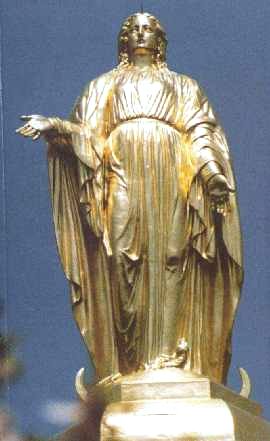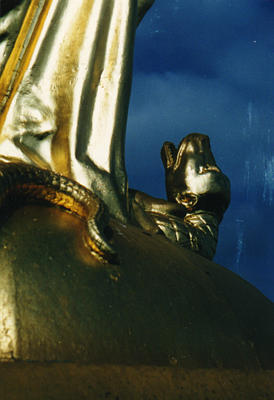
"And there appeared a great wonder in heaven: a woman clothed with the sun, and the moon under her feet, and on her head a crown of twelve stars (Apoc., XII, I). What a beautiful sight! -- one that has never been seen in this country." -- Sorin
In 1883 the Scholastic described the Virgin Mary's statue in Rome which was the inspiration for Fr. Sorin's statue of the Blessed Virgin on Notre Dame's Golden Dome:
The model of the statue is that adopted by our late Holy Father, Pope Pius IX, in 1854, on the occasion of the solemn proclamation of the dogma of the Immaculate Conception [erected by Pius IX in front of the Propaganda College in Piazza di Spagna in Rome]. The material will be of highly polished bronze, sixteen feet in height, the crescent with the serpent beneath, and a starry crown above." -- Scholastic, 13 October 1883, V. 17, p. 88.
Fulton J. Sheen explains that the Immaculate Conception "is a doctrine of the Roman Catholic Church. It means that the Virgin Mary, in order to be pure enough to become the mother of Christ, was conceived free from the burden of original sin. Her soul was created in the purest holiness and innocence."
He goes on to say:
The term is often confused among non-Catholics with the Virgin Birth. But this term has no connection with the Immaculate Conception. Mary had two human parents. The Virgin Birth implies a miracle, namely that Christ was "conceived by the Holy Ghost and born of the Virgin Mary." She had asked the angel Gabriel how she, a virgin, should become the mother of the promised Messiah, and she was told this would be by the power of God (Luke I:34-38). The Roman Catholic Church has always upheld these two articles of faith. -- Fulton J. Sheen, The World Book Encyclopedia, Vol. 10, p. 67
Mary the new Eve
The New Catholic Encyclopedia explains why Mary was referred to as the new Eve which also explains the presence of the serpent, shown at the base of her statue in the photograph below:

. . . The word, "woman," aptly portrays Johannine symbolism with regard to Mary's role in giving life to the Life-giver as Adam calls his wife "Life" (Zwn') in Gn 3.20, because she is the mother of all living, similarly John suppresses Mary's name, calling her simply "woman" in order to present her as the new Eve, the mother of all whom Jesus loves in the person of "the disciple whom he loved." John also never mentions this Disciple's name in order to emphasize his symbolic role. Thus, John proclaims the spiritual motherhood of Mary, the new Eve, with regard to the faithful represented by the beloved disciple. -- The New Catholic Encyclopedia, V. 13, p. 139.
Psalm 91 is consistent with this explanation:
Because you have made the Lord your refuge, the Most High your habitation, no evil shall befall you, no scourge come near your tent. For he will give his angels charge of you to guard you in all your ways. On their hands they will bear you up, lest you dash your foot against a stone. You will tread on the lion and the adder, the young lion and the serpent you will trample under foot." -- Psalms 91:9-16 RSV.
The Catholic Encyclopedia article on the Immaculate Conception is also consistent with these interpretations:
The person of Mary, in consequence of her origin from Adam, should have been subject to sin, but, being the new Eve who was to be the mother of the new Adam, she was, by the eternal counsel of God and by the merits of Christ, withdrawn from the general law of original sin. Her redemption was the very masterpiece of Christ's redeeming wisdom. He is a greater redeemer who pays the debt that it may not be incurred, than he who pays after it has fallen on the debtor (Ullathorne, 'Immac. Conception', p. 89). Such is the meaning of the term 'Immaculate Conception'.
. . . No direct or categorical and stringent proof of the dogma can be brought forward from Scripture. But the first scriptural passage which contains the promise of the redemption, mentions also the Mother of the Redeemer. The sentence against the first parents was accompanied by the Earliest Gospel (Proto-evangelium), which put enmity between the serpent and the woman: "and I will put enmity between thee and the woman and her seed; she (he) shall crush thy head and thou shalt lie in wait for her (his) heel" (Gen., iii, 15). The translation "she" of the Vulgate is interpretative; it originated in the fourth century ('Katholik', 1893, 425) and cannot be defended critically." -- The Catholic Encyclopedia, V. VII, p. 675.
Genesis relates the story of Eve and the apple:
Then the Lord God said to the woman, "What is this that you have done?" The woman said, "The serpent beguiled me, and I ate." The Lord God said to the serpent, "Because you have done this, cursed are you above all cattle, and above all wild animals; upon your belly you shall go, and dust you shall eat all the days of your life. -- Genesis 3:13-14 RSV
Revelation also speaks of Satan and the serpent: "And the great dragon was thrown down, that ancient serpent, who is called the Devil and Satan, the deceiver of the whole world . . . ." -- Revelation 12:9 RSV
As does the dictionary definition: "Satan (especially in Christian Theology) the supreme evil spirit; the enemy of goodness and great adversary of God and mankind; the Devil." -- The World Book Dictionary
These excerpts from a variety of sources may help explain the significance of these interesting details placed at the base of Sorin's statue of the Blessed Virgin.
Although the electrified crown of stars originally placed on the Virgin Mary's statue on the Dome has since been removed, the crescent moon and the serpent are still there. They were photographed close-up during the recent restoration of the main building by Robert F. Ringel a staff architect, artist and photographer on campus. One can see in these close-up photographs of the base of the statue that Sorin took great care, especially with the serpent portion of the figure, even though that portion would have been invisible to the eye from the ground and is only faintly visible in the first full-length photograph of the statue shown in the beginning.

The World Book Dictionary gives this definition of the crescent new moon displayed at the base of Our Lady's statue which when it was electrified was aglow with light at night, as was the crown of stars in its early days: "crescent 1. shaped like the moon in its first or last quarter. 2. growing; increasing; developing: There is many a youth Now crescent, who will come to all I am (Tennyson)."
Sorin must have known this definition of the crescent moon at the time and would have considered it an apt description of his New Notre Dame -- "ever growing; increasing; and developing" far above and way beyond even his own great expectations.
Whatever the complete and definitive theological reasons for the impressive details at the base of Sorin's grand statue on the Dome of his New Notre Dame, one thing is certain. Sorin went to great lengths to erect a beautiful figure of Our Lady as a fitting expression of gratitude for the graces she had already bestowed upon the university: "that she might stand upon her magnificent throne, and with extended arms, give the assurance of the continued protection of her whom it represents -- a thing of beauty to rest and shine there, a joy forever."